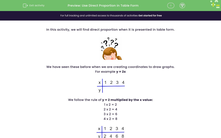In this activity, we will find direct proportion when it is presented in table form.

We have seen these before when we are creating coordinates to draw graphs.
For example y = 2x
We follow the rule of y = 2 multiplied by the x value:
1 x 2 = 2
2 x 2 = 4
3 x 2 = 6
4 x 2 = 8
The graph can now be plotted!
Does that make sense?

Great! In this activity, we will be using the same idea, but we have to find the rule.
Confused? Let's have a look at an example to help!
Example
y is directly proportional to x
Complete the table below:
Answer
We need to look at the table to see where we have the x and the y values.
We can use these to find the rule.
We have x = 5 when y = 20
To find the multiplier, we can do 20 ÷ 5 = 4
So, we can see that y = 4x
or
the y values are 4 times bigger than the x values.
We can now fill in the gaps:
When x = 3, then y = 4 x 3 = 12
When x = 8, then y = 4 x 8 = 32
Let's try some more of these!







